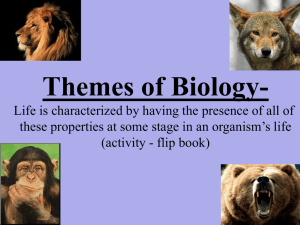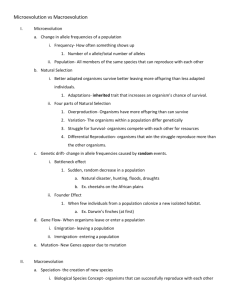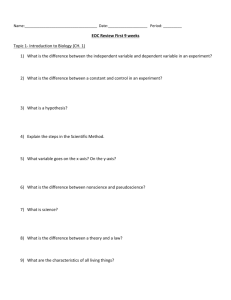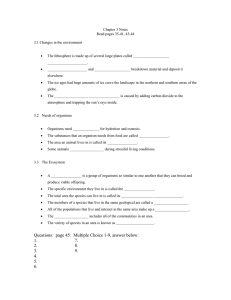Chapters 16 and 17: Evolution – part II
advertisement
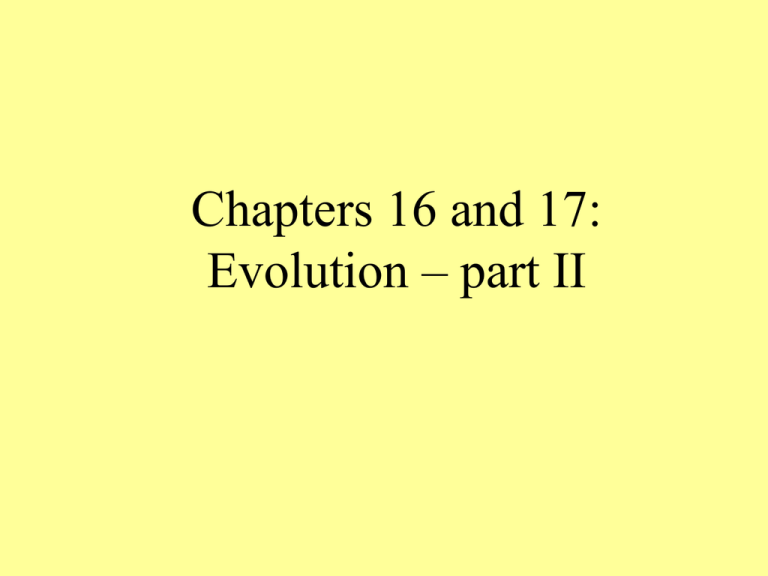
Chapters 16 and 17: Evolution – part II Evidence for evolution • • • • Fossils Biogeography Developmental biology Anatomy • Homologous structures • Analogous structures • Vestigial organs • Biochemistry •Fossil Evidence •Fossils – traces of organisms that lived in the past •Ex: shells, bones, teeth, imprints •Tell us things such as age, habitat, diet, & lifestyle of organisms. •Record is incomplete – many organisms leave no fossils behind •Most found embedded in sedimentary rock •Usually, any given layer is older than the one above it, and younger than those below. •Biogeography - the study of the locations of organisms around the world •Darwin saw similarities of organisms on different continents but similar environments •Differences in organisms due to geographic separation •Continental drift can explain how some of this may have occurred – distribution of plants and animals is consistent with this Emu (Australia) Ostrich (Africa) Rhea (South America) Similar animals from different continents Continental drift •Developmental biology – the more similar the embryos are at certain stages of development, the more closely related they are thought to be. Significance of developmental similarities Human embryo at 5-6 weeks of development Anatomical Evidence • All vertebrate forelimbs contain the same sets of bones – this strongly suggests common they evolved from a common ancestor. • Homologous structures – characteristics that are similar in two or more species and that have been inherited from a common ancestor of those species • Ex: frog, lizard, bird, whale, cat, bat, and human forelimbs Bones of vertebrate forelimbs • Analogous structures - used for the same purpose but are not due to a common ancestor • Ex: bird wing & insect wing • Vestigial structures – structures that have no function in the living organism but may have been used by its ancestors. • Ex: human appendix, python leg bones • Biochemistry – comparisons of DNA or amino acid sequences in proteins • The more similar the genes and proteins are, the more closely related organisms are thought to be • Ex: Hemoglobin to carry oxygen is identical in humans and chimpanzees. • All use DNA, ATP, and many identical or nearly identical enzymes. • Organisms use the same triplet code and the same 20 amino acids in proteins. • Universal genetic code is evidence for evolution Significance of biochemical differences Population genetics •Gene pool – total of all the genes of all the individuals in a population •If the frequency of genes in a population changes, evolution has occurred •Gene frequencies will change to confer survival and reproductive success Microevolution vs. macroevolution •Microevolution – refers to evolution as a change in genes within populations •Macroevolution – refers to the appearance of new species over time •Speciation – the formation of a new species •Species – a group of organisms that are closely related and that can mate and produce fertile offspring •New species appear when reproductive isolation occurs Example of microevolution •Speciation occurs when one population is isolated from another population •Isolation can be geological, reproductive, or filling different ecological niches to reduce competition •With isolation comes changing environmental factors exerting selective pressure on mutations and adaptations. • Reproductive isolation: a state in which a population can no longer interbreed with other populations to produce future generations • Reproductive isolation can occur due to: – Pre-mating isolating mechanism reproduction is not attempted – Post-mating isolating mechanisms - do not produce fertile offspring • Hybrids - Offspring produced by the interbreeding between two different species • Examples of hybrids: 1. Zebra x horse 2. M. lion & F. tiger 3. F. lion & M. tiger 4. Killer whale & dolphin 5. M. donkey & F. horse 6. F. donkey & M. horse 7. Zebra x donkey 8. Camel x llama 9. Buffalo x cow 10.Sheep x goat 11.Lemon x lime 12.Tangerine x lemon 13.Broccoli x cauliflower 14.Tangerine x grapefruit 15.Grape x apple Processes of microevolution: •Natural selection – some are better suited to survive and reproduce than others •Migration – movement of individuals into, out of, or between populations http://nortonbooks.com/college/biology/animations/ch17a01.htm •Mate choice – mates are limited, or selecting a mate based on appearance or behavior •Mutation – changes genes within population •Genetic drift – random events cause only certain individuals to survive and reproduce genetic drift animation •Examples of genetic drift: •Founder effect - Founding member of Amish population had recessive allele for rare kind of dwarfism - % of Amish with this allele higher than in general population •Random death of certain color animals results in only one color reproducing next generation Patterns of macroevolution: •Convergent evolution •Coevolution •Adaptive radiation •Extinction – if all members of a species die off or fail to reproduce, the species is said to be extinct •Gradualism •Punctuated equilibrium •Convergent evolution – species living in similar environments should evolve similar adaptations •Coevolution – change of two or more species in close association with each other •Ex: predator & prey, parasite & host, insects and plants they pollinate Other examples • Adaptive radiation - an evolutionary pattern in which many species evolve from a single ancestral species • Tends to happen when a new species enters an environment that contains few other species – Ex: several species of finches on the Galapagos Islands - each one has a different way of life. The Galapagos finches • Gradualism – suggests that change is slow and steady; large-scale changes require many small-scale changes over a period of time. • Punctuated equilibrium – suggests that a period of no change is interrupted by period of rapid change; species is stable, then environmental changes create new pressures, causing new species to suddenly appear Gradualism versus punctuated equilibrium
